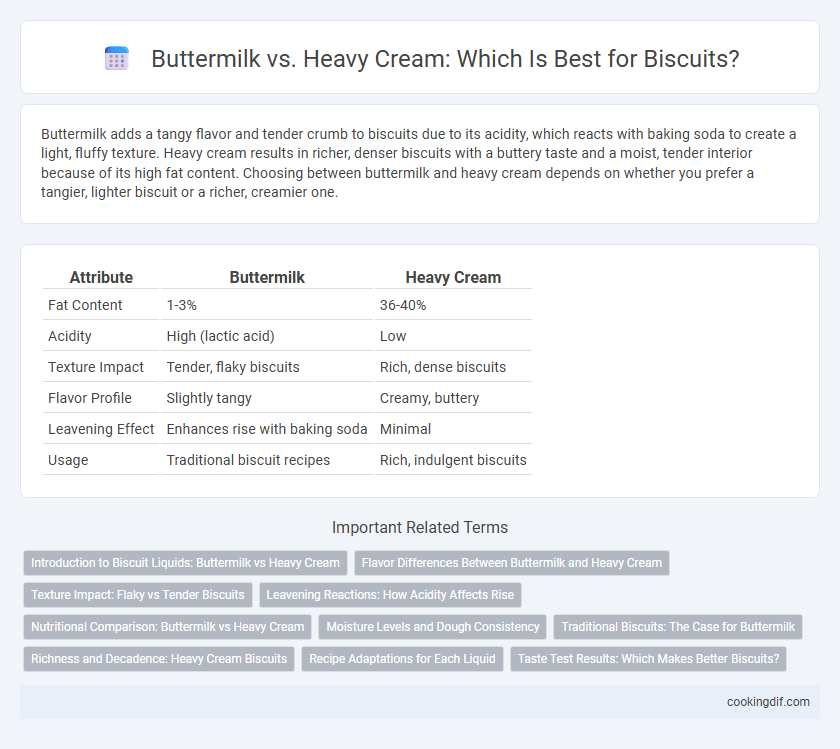Buttermilk adds a tangy flavor and tender crumb to biscuits due to its acidity, which reacts with baking soda to create a light, fluffy texture. Heavy cream results in richer, denser biscuits with a buttery taste and a moist, tender interior because of its high fat content. Choosing between buttermilk and heavy cream depends on whether you prefer a tangier, lighter biscuit or a richer, creamier one.
Table of Comparison
| Attribute | Buttermilk | Heavy Cream |
|---|---|---|
| Fat Content | 1-3% | 36-40% |
| Acidity | High (lactic acid) | Low |
| Texture Impact | Tender, flaky biscuits | Rich, dense biscuits |
| Flavor Profile | Slightly tangy | Creamy, buttery |
| Leavening Effect | Enhances rise with baking soda | Minimal |
| Usage | Traditional biscuit recipes | Rich, indulgent biscuits |
Introduction to Biscuit Liquids: Buttermilk vs Heavy Cream
Buttermilk and heavy cream each play distinct roles in biscuit recipes, influencing texture and flavor profiles uniquely. Buttermilk, with its acidic nature and lower fat content, tenderizes the dough and imparts a slight tanginess, resulting in fluffy, light biscuits. Heavy cream, rich in fat and smooth in consistency, produces biscuits with a denser crumb and richer taste, emphasizing moisture and buttery richness.
Flavor Differences Between Buttermilk and Heavy Cream
Buttermilk imparts a tangy, slightly sour flavor to biscuits, enhancing their depth and balancing the richness of the dough. Heavy cream, on the other hand, offers a rich, buttery taste that produces a more indulgent, tender crumb. The choice between buttermilk and heavy cream significantly influences the final biscuit's flavor profile and texture.
Texture Impact: Flaky vs Tender Biscuits
Buttermilk produces biscuits with a tender crumb and slight tang due to its acidity, which reacts with baking soda to create a softer texture. Heavy cream, rich in fat, results in flakier biscuits by creating steam pockets during baking that separate the dough layers. Choosing between buttermilk and heavy cream significantly influences the biscuit's texture, balancing tenderness versus flakiness.
Leavening Reactions: How Acidity Affects Rise
Buttermilk's acidity reacts with baking soda to produce carbon dioxide, creating a lighter and fluffier biscuit texture through enhanced leavening. Heavy cream, lacking acidity, relies mainly on baking powder or mechanical aeration for rise, often resulting in a denser, richer biscuit. The acid content in buttermilk accelerates leavening reactions, making it a preferred liquid for achieving optimal biscuit volume and tenderness.
Nutritional Comparison: Buttermilk vs Heavy Cream
Buttermilk contains approximately 99 calories and 2 grams of fat per cup, along with beneficial probiotics and lower saturated fat compared to heavy cream, which has about 821 calories and 88 grams of fat per cup. The high fat content in heavy cream contributes to richer, flakier biscuits but also increases saturated fat intake significantly. Choosing buttermilk in biscuit recipes adds a tangy flavor with fewer calories and supports digestive health due to its live cultures.
Moisture Levels and Dough Consistency
Buttermilk provides higher moisture content and a slightly acidic pH that tenderizes biscuit dough, resulting in a softer, more tender crumb. Heavy cream has a higher fat content but lower moisture compared to buttermilk, producing a richer dough that is denser and less hydrated. The choice between buttermilk and heavy cream significantly impacts dough consistency and final biscuit texture, with buttermilk delivering lighter, fluffier biscuits and heavy cream yielding richer, denser results.
Traditional Biscuits: The Case for Buttermilk
Traditional biscuits achieve their signature tender crumb and rich flavor primarily through the use of buttermilk, whose mild acidity reacts with baking soda to create a superior rise and softness. Buttermilk's lower fat content compared to heavy cream allows for a lighter texture, ensuring biscuits remain fluffy rather than dense. The subtle tang of buttermilk enhances the overall taste profile, making it the preferred liquid for classic Southern-style biscuits.
Richness and Decadence: Heavy Cream Biscuits
Heavy cream biscuits deliver an unmatched richness and decadence due to their high fat content, which creates a tender, flaky texture with a buttery flavor. The dense cream adds moisture, resulting in biscuits that are both indulgent and satisfying. Buttermilk, while adding a slight tang and aiding in leavening, cannot replicate the luxurious mouthfeel that heavy cream imparts.
Recipe Adaptations for Each Liquid
Buttermilk imparts a tangy flavor and tender crumb to biscuits, reacting with baking soda for better rise, making it essential for recipes calling for leavening adjustments. Heavy cream yields richer, denser biscuits with a buttery taste and requires reducing other fats in the dough to maintain the right texture. Adapting recipes involves balancing acidity and fat content: substitute buttermilk with cream by adding an acid like lemon juice or vinegar to mimic the chemical reaction, or reduce fat when using cream to prevent overly heavy biscuits.
Taste Test Results: Which Makes Better Biscuits?
Buttermilk produces biscuits with a tangier, more complex flavor profile and a tender crumb due to its acidity, which reacts with baking soda for better rise. Heavy cream yields richer, more buttery biscuits with a denser texture but less pronounced tanginess. Taste test results consistently favor buttermilk for balanced flavor and fluffier texture, while heavy cream appeals to those seeking indulgent richness.
Buttermilk vs Heavy cream for biscuit liquid Infographic

 cookingdif.com
cookingdif.com